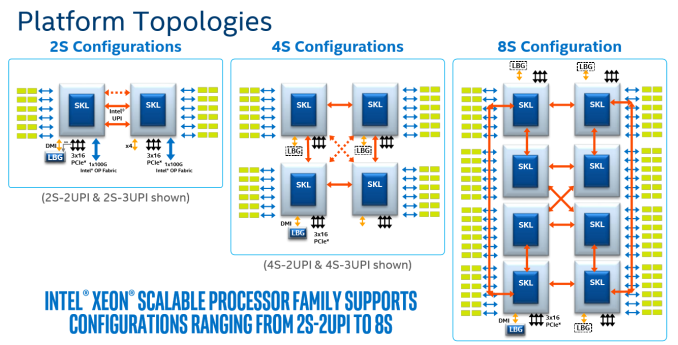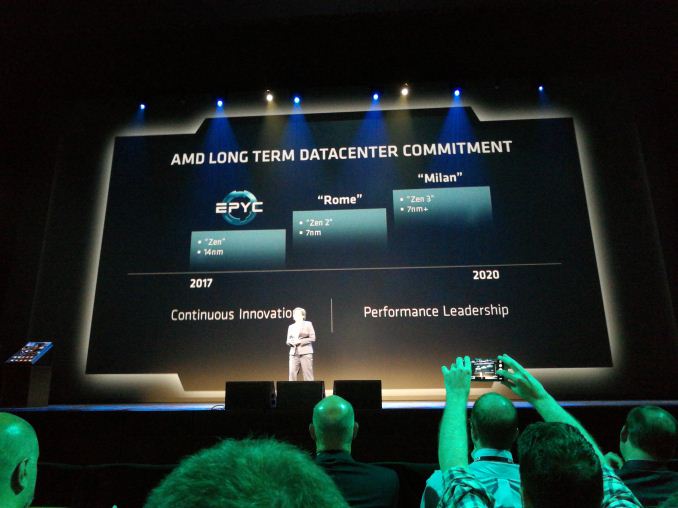Sizing Up Servers: Intel's Skylake-SP Xeon versus AMD's EPYC 7000 - The Server CPU Battle of the Decade?
by Johan De Gelas & Ian Cutress on July 11, 2017 12:15 PM EST- Posted in
- CPUs
- AMD
- Intel
- Xeon
- Enterprise
- Skylake
- Zen
- Naples
- Skylake-SP
- EPYC
Closing Thoughts
First of all, we have to emphasize that we were only able to spend about a week on the AMD server, and about two weeks on the Intel system. With the complexity of both server hardware and especially server software, that is very little time. There is still a lot to test and tune, but the general picture is clear.
We can continue to talk about Intel's excellent mesh topology and AMD strong new Zen architecture, but at the end of the day, the "how" will not matter to infrastructure professionals. Depending on your situation, performance, performance-per-watt, and/or performance-per-dollar are what matters.
The current Intel pricing draws the first line. If performance-per-dollar matters to you, AMD's EPYC pricing is very competitive for a wide range of software applications. With the exception of database software and vectorizable HPC code, AMD's EPYC 7601 ($4200) offers slightly less or slightly better performance than Intel's Xeon 8176 ($8000+). However the real competitor is probably the Xeon 8160, which has 4 (-14%) fewer cores and slightly lower turbo clocks (-100 or -200 MHz). We expect that this CPU will likely offer 15% lower performance, and yet it still costs about $500 more ($4700) than the best EPYC. Of course, everything will depend on the final server system price, but it looks like AMD's new EPYC will put some serious performance-per-dollar pressure on the Intel line.
The Intel chip is indeed able to scale up in 8 sockets systems, but frankly that market is shrinking fast, and dual socket buyers could not care less.
Meanwhile, although we have yet to test it, AMD's single socket offering looks even more attractive. We estimate that a single EPYC 7551P would indeed outperform many of the dual Silver Xeon solutions. Overall the single-socket EPYC gives you about 8 cores more at similar clockspeeds than the 2P Intel, and AMD doesn't require explicit cross socket communication - the server board gets simpler and thus cheaper. For price conscious server buyers, this is an excellent option.
However, if your software is expensive, everything changes. In that case, you care less about the heavy price tags of the Platinum Xeons. For those scenarios, Intel's Skylake-EP Xeons deliver the highest single threaded performance (courtesy of the 3.8 GHz turbo clock), high throughput without much (hardware) tuning, and server managers get the reassurance of Intel's reliable track record. And if you use expensive HPC software, you will probably get the benefits of Intel's beefy AVX 2.0 and/or AVX-512 implementations.
The second consideration is the type of buyer. It is clear that you have to tune more and work harder to get the best performance out of AMD EPYC CPUs. In many ways it is basically a "virtual octal socket" solution. For enterprises with a small infrastructure crew and server hardware on premise, spending time on hardware tuning is not an option most of the time. For the cloud vendors, the knowledge will be available and tuning for EPYC will be a one-time investment. Microsoft is already deploying AMD's EPYC in their Azure Cloud Datacenters.
Looking Towards the Future
Looking towards the future, Intel has the better topology to add more cores in future CPU generations. However AMD's newest core is a formidable opponent. Scalar floating point operations are clearly faster on the AMD core, and integer performance is – at the same clock – on par with Intel's best. The dual CCX layout and quad die setup leave quite a bit of performance on the table, so it will be interesting how much AMD has learned from this when they launch the 7 nm "Rome" successor. Their SKU line-up is still very limited.
All in all, it must be said that AMD executed very well and delivered a new server CPU that can offer competitive performance for a lower price point in some key markets. Server customers with non-scalar sparse matrix HPC and Big Data applications should especially take notice.
As for Intel, the company has delivered a very attractive and well scaling product. But some of the technological advances in Skylake-SP are overshadowed by the heavy price tags and somewhat "over the top" market segmentation.












219 Comments
View All Comments
twtech - Thursday, July 20, 2017 - link
I'd really like to see some compile-time benchmarks for these CPUs.For my own particular interests, time taken to do a full recompile of the Unreal 4 engine from source would be very useful. But even something more generic like the Linux kernel compiles per hour benchmark could serve as a useful point of reference.
szupek - Friday, July 21, 2017 - link
Meanwhile, the entire world still runs on IBM's DB2 for Datbases and IBM's Z/AS400 Mainframes. The fastest database in the world, by far...oh and the most secure (it's only hackable by standing in front of the console, seriously). Every single credit card transaction. Every single plain ticket. Most medical records and all of wall street. Yup. IBM still owns. So much that most of commenters probably have no idea just how big IBM truly is. If you care about Database speed & security, these processors shouldn't appeal to you.stevefan1999 - Saturday, July 22, 2017 - link
It's impossible for AMD to win completely.Remember kids, public cloud service providers such as Amazon(AWS), Google(GCP) and Joyent would still stick with Intel due to not only the compatibility issues like ecosystem and vendor inconsistency, but also the VM migration and security and module issues, all mentioned in the presentation slides presented by Intel. They are a very serious matter, as they, the public cloud services, are powering the Internet we use everyday, so being stable, consistent and be able to serve a good amount of SLA is vital to the public cloud, we wouldn't expect them to play with the new lad in the hood, the EPYC.
IIRC only the Microsoft(Azure) are using AMD server CPUs partially in some of their datacenters, running various Linux and Windows VMs using Hyper-V, and they have been performing quite well
The cloud services are exploding every year, but with what I've said, I doubt AMD could even kick in the first door at least for 3 to 4 years. This is still a big-win for Intel and what manipulations will Intel do I don't know.
On the other hand, Intel has failed to service the desktop market and they're figuring out how to hold their asses on the Internet infrastructure, never had them know the crusade of EPYC will come this fast.
The server market is quite a big meat, it's a 21 bil market, cool right? But that you will have guaranteed 'server upgrade' every year, is a bigger matter, as those server CPUs are designated to be disposed given the wattage and performance per dollar is lower on the newer CPUs. Those god-damn server operators will keen to replace their CPU (and therefore some serious metal pollution issues). Intel has been exploiting this and gained a big hurdle of money and therefore had their ecosystem grown. This is how Intel defends their platform by vendor lock-in, pathetic.
AMD is now being performance and cost competitive to Intel, but it's still dead in the High Performance Computing campaign unless AMD could provide higher frequencies. Well I have to say I know nothing about HPC, but I remembered the Bulldozer architecture of AMD is actually targeted and marketed for HPC! That's why AMD failed in general-purpose computing market and started the downfall of AMD/Domination of Intel 5 years ago. Even though we know the fate of Bulldozer, but hopefully AMD could still scrap some of the HPC goodies of Bulldozer out and benefits the mankind by accelerating researches such as finding the cures for cancer or solving some precise physics and mathematics.
Well, anyway the cloud, the HPC and the server market are the last resort for Intel and they will definitely hold their last ground. Good luck AMD on crushing the mean and obese Intel!
errorr - Sunday, July 23, 2017 - link
For all the talk about speed and efficiency the problem is about $$$. The sad fact is that what matters most isn't even the price of the cpus which is chump change in the grand scheme of things but how the software licensing costs are determined. Per core or per socket software pricing will matter a lot. The software companies will decide how successful EPYC is. I have a feeling they will be biased slightly toward AMD at the beginning as it is in their interest to foster competition for Intel, or if they are not forward looking enough the end customers might argue that the competition will benefit the SW companies in the long run by continuing to push competition.msroadkill612 - Thursday, July 27, 2017 - link
Whatever, its all pointless if the competition can read your secrets, which is a matter very close to the hearts of the cheque signers.AMD seem to have something very superior to offer in that department.
qweqwe - Tuesday, August 8, 2017 - link
we just did some heavy inhouse hpc-tests with epyc against diff. intel servers.the epyc is the clear winner in terms of performance and power consumption when it
comes to hand-tuned parallel-vector-code examples.
not bad amd !
readonly1 - Friday, October 27, 2017 - link
qweqwe, I totally agree with you. Our inhouse HPC tests get the similar conclusion, after comparing AMD Epyc 7351 (dual socket, 32 cores, 2400Mhz) and Intel SKylake 6154 (dual socket, 36 cores, 3000Mhz). I think AMD clearly wins in the memory bandwidth, which is extremely important for HPC computation.msroadkill612 - Monday, November 13, 2017 - link
7/11/2017 "Microsoft is already deploying AMD's EPYC in their Azure Cloud Datacenters."Interesting. As i have been theorising, a possible reason for the absence of retail epyc is not supply, but demand.
A single sale can soak up production runs.
If so tho, not much sign of big revenues from it yet, but there are other explanations for that. Contra processors for development work e.g.
q.epsilon.p - Sunday, June 10, 2018 - link
power consumption numbers with every benchmark would have been nice, because these parts are server benchmarks, Perf / Watt is one of the primary concerns. And where AMD kinda crush Intel, because it's isn't exactly being honest with it's TDP values nowadays when it comes to Data Centre and HEDT.TDP was traditionally the absolute maximum the CPU would put out as heat, now with a power consumption of 670W I am assuming that the heat being put out by the CPU is more than 165W.